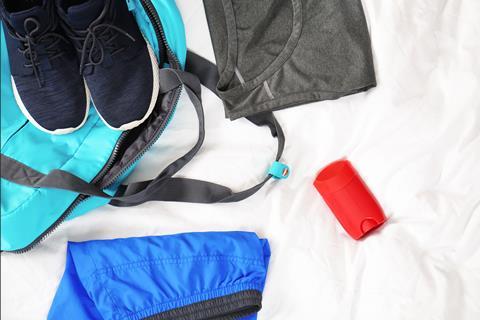Deodorant vs antiperspirant: what’s the difference?
No one likes the reek of old gym clothes or feeling sweaty and stinky after a long, hot day. Chemists have been fighting against such whiffs and pongs for thousands of years. In fact, one of the first recorded chemists in history, Tapputi-Belatekallim, was a perfumer who lived around 1200BC in what is now Iraq. Our need to smell fresh has led to some simple yet clever chemistry.
No one likes the reek of old gym clothes or feeling sweaty and stinky after a long, hot day. Chemists have been fighting against such whiffs and pongs for thousands of years. In fact, one of the first recorded chemists in history, Tapputi-Belatekallim, was a perfumer who lived around 1200BC in what is now Iraq. Our need to smell fresh has led to some simple yet clever chemistry.

Body odour explained
Sweat doesn’t have a smell: it is the bacteria that live naturally on our skin and in our sweat glands that cause body odour. We all have around 1000 different species of bacteria on us at all times, with millions of individual bacterium per square centimetre. These bacteria break down fats and acids in sweat – which the apocrine glands produce – creating whiffy waste products. These unpleasant smelling molecules include propanoic acid, which gives off a vinegary smell, 3-methylhex-2-enoic acid, which smells like goat, and 3-methyl-3-sulfanylhexan-1-ol, which smells like onions.
No one’s sweat is the same. Our diets change its composition, with certain foods creating particularly pungent odours. Genetics also play a role – around 2% of the UK population has a rare form of the gene ABCC11 which means they don’t produce body odour at all.
Sweat prevention
Now that we know what’s causing the smell, how best do you deal with it? Typically, we use a spray, where the active ingredients dissolve in a pressurised solvent, which then evaporates to leave the ingredients on the skin; or a stick, which uses a combination of waxes and oils to rub the ingredients where we want them.
If antiperspirants act at the source of body odour, then deodorants tackle the result
The ingredients in these sprays and sticks fall into two main categories: antiperspirants and deodorants. Antiperspirants stop sweating by physically blocking the apocrine glands with a plug. Most antiperspirants contain aluminium or zirconium salts, with the metal forming a cap over the glands to stopper them. For decades, rumours have persisted linking the use of antiperspirants containing aluminium to cancers and other health conditions, but there is currently no solid evidence to support these claims.
The ingredients in these sprays and sticks fall into two main categories: antiperspirants and deodorants. Antiperspirants stop sweating by physically blocking the apocrine glands with a plug. Most antiperspirants contain aluminium or zirconium salts, with the metal forming a cap over the glands to stopper them. For decades, rumours have persisted linking the use of antiperspirants containing aluminium to cancers and other health conditions, but there is currently no solid evidence to support these claims (bit.ly/4ho9SON).
Some products are called natural antiperspirants and usually include ingredients such as corn starch. In reality, these aren’t antiperspirants at all – they absorb sweat as it emerges, rather than blocking the gland. The best-known product of this type is talc, a mineral made of magnesium silicate, which absorbs water released in sweat. Professional sports people, such as gymnasts and weightlifters, often use talc to ensure they have a dry grip.
Neutralising unwanted smells
If antiperspirants act at the source of body odour, then deodorants tackle the result. Deodorants usually contain powerful, pleasant fragrances to mask a natural musk: essentially replacing one smell with another. Unlike perfumes, which aim to enhance a smell, deodorants use scent combinations to neutralise odours. But they can also contain compounds that target the bacteria more directly. The most controversial molecule of this type is the antimicrobial triclosan, which is banned in several countries (but not the UK). Triclosan works by making skin more acidic, creating an environment that stops bacteria from growing, preventing them from creating body odour.
The problem with its use is that our skin is a complicated ecosystem; if you get rid of all the natural bacteria, makng serious bacterial infections harder to treat. There are also concerns that triclosan use could contribute to increased antibiotic resistance, leaving serious bacterial infections harder to treat.
If you’re looking to battle your body odour, chemistry has you covered. But if your smell is still bothering you after using these products, remember that your internal chemistry can be a contributing factor. Changing your diet can also help cut down on any unwanted stink coming from under your arms.
It would stink if you missed this TikTok:
@royalsocietyofchemistry 🦨 Do you start to stink if the sun's out? 🌞 It's natural to sweat, but when you do, what's the best product to use? Jo explains the scientific differences between #antiperspirant and #deodorant and how they work together to make you smell like roses 🌹and not onions 🧅 Remember not to worry when you're perspiring in your #PE lesson, as #chemistry has got your back🧪💪 #LearnOnTikTok #Chemistry #Science #STEM #Sweating #Summer #HotWeather #GCSE #WorldDeodorantDay ♬ Exciting, exciting, cute songs(1283711) - Korepoi
Kit Chapman














1 Reader's comment